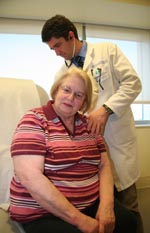|
By
Cindy Abole
Public Relations
A month ago, Lisa Miles struggled to do simple chores around her
country home in Cordova, just miles outside of Orangeburg. Years
earlier when Miles underwent a successful double bypass heart surgery
at MUSC she entrusted the physicians and staff for her specialized
care. Recently, Miles returned to MUSC to help manage other medical
complications and was guided to the care of physicians at Ashley River
Tower's new Vascular Interventional Radiology (VIR) outpatient clinic.
The VIR clinic was
established to provide quality comprehensive medical care and expertise
in a visible and accessible location for patients. The weekly clinic,
located in the same first-floor clinical area shared by cardiology,
vascular and gastrointestinal surgery, opened its doors last November.
Since 1993, the division established themselves by performing about
1,300 minimally-invasive procedures. Today, thanks to advances in
technology and patient outcomes, that number has almost quadrupled to
more than 7,500 specialty procedures in 2009.
 VIR clinic physician Dr. Marcelo
Guimaraes checks the lungs of patient Gail Kemp. VIR clinic physician Dr. Marcelo
Guimaraes checks the lungs of patient Gail Kemp.
Marcelo Guimaraes, M.D.,
assistant professor of vascular and interventional radiology in MUSC's
Heart & Vascular Center, said that the VIR clinic is a dedicated
clinic focused on patient care services while working collaboratively
with referring primary care physicians and other medical specialists.
"The new clinic is
dedicated to accommodating patients for both pre-and-post operative
procedures and for the screening of patients with peripheral arterial
disease. We're focused on patient education, prevention and early
management of peripheral vascular disease which is highly prevalent in
South Carolina," he said.
The VIR clinic also
enhances and increases the level of quality service and patient care
that we strive to provide our patients, he said. Medical innovation and
the development of minimally-invasive procedures guided by imaging
under the Division of Interventional Radiology has been present at MUSC
since the 1990s. It was vascular and interventional radiologists who
pioneered balloon angioplasty and stent placement to treat peripheral
arterial disease. The VIR team has since worked in collaboration with
vascular, cardiothoracic surgery and cardiology in this field.
Traditionally,
interventional radiologists were regarded as procedure-operator
specialists based solely in dedicated suites and units under the
Department of Radiology's Vascular and Interventional Radiology
Division. Later, their expertise evolved and they became more available
for specialty consults for procedure planning in a patient's team
approach to care. But the practice and need for more patients to be
treated using non-surgical, low-risk procedures continue to grow,
according to Guimaraes. The MUSC Interventional Radiology team knew
they needed to plan how to best accommodate patients with more
convenient and comprehensive services, such as the weekly clinic as a
resource for optimum care.
Renan B. Uflacker, M.D.,
Interventional Radiology director, said he feels the clinic meets the
needs of what their services couldn't provide before—a comprehensive
approach to minimally-invasive procedures.
"The patients know ahead
of time what the procedures are about, understand the indications and
the risks and benefits involved and know what to expect in the future.
The clinic is just one tool our Interventional Radiology Division
provides to improve services by treating more complex patients with the
highest standards of medical care as possible. We feel much more
proactive today, working like surgeons, in closing that gap of care and
providing long-term follow up care for our patients."
The VIR division has five
interventionists who share strong training and experience in
minimally-invasive therapy procedures. These specialists can perform
more than 50 different types, including treating patients diagnosed
with arterial and venous disease (atherosclerosis, blood clots) carotid
stenosis and oncology patients (using cryo, microwave and
radiofrequency ablations, as well as chemoembolization—all under image
guidance) used to treat cancers of the liver, kidney and lungs. Once a
patient receives care, they are redirected to their referring or
primary care physician.
Results from a peripheral
vascular test in January led Miles to the VIR clinic and Guimaraes'
care. On March 15, she traveled to Charleston for a 45 minute-long
abdominal aortic stent placement procedure conducted by Guimaraes.
Hours later, Miles was walking around and resting back at home.
"I felt good," she said,
comparing her recovery time from the invasive procedure to previous
open heart surgery. "I felt blessed to be able to walk and do things
around my house again."
"It is important to share
with our colleagues a shift in the way we are practicing medicine and
our full commitment to the best care for our patients, not only as
minimally invasive techniques operators, but as VIR physicians capable
of providing comprehensive care," Guimaraes said.
ART's VIR clinic is open
on Thursday afternoons. To schedule an appointment, call 876-5558.
|



 VIR clinic physician Dr. Marcelo
Guimaraes checks the lungs of patient Gail Kemp.
VIR clinic physician Dr. Marcelo
Guimaraes checks the lungs of patient Gail Kemp.